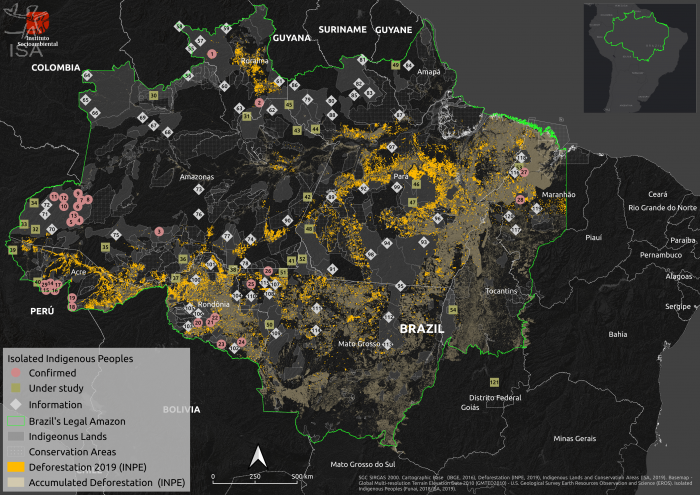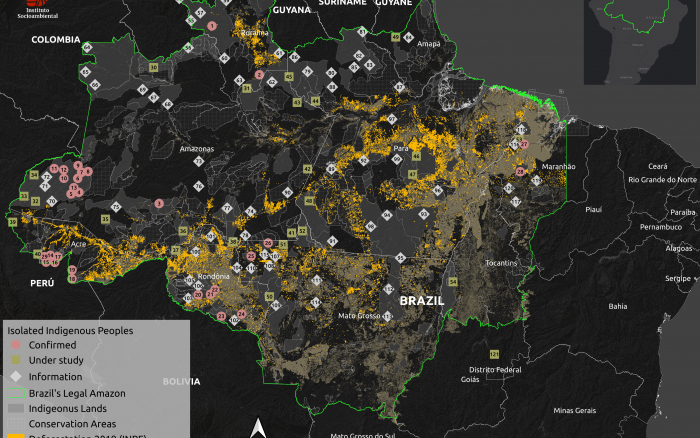Você está na versão anterior do website do ISA
Atenção
Essa é a versão antiga do site do ISA que ficou no ar até março de 2022. As informações institucionais aqui contidas podem estar desatualizadas. Acesse https://www.socioambiental.org para a versão atual.
ISA Report at the UN Denounces High Risk of Genocide of Isolated Indigenous Peoples
Friday, 28 de February de 2020 
Yanomami
Awá-Guajá
Avá Canoeiro
Vale do Javari
Esta notícia está associada ao Programa:
Data presented on Tuesday at a hearing in Geneva indicate that deforestation and invasions have skyrocketed in the last year in Amazon territories inhabited by these groups, the most vulnerable to disease and forest loss.
This explosion in deforestation has been greater in territories with a presence of isolated indigenous peoples. Data from the Socio-environmental Institute (ISA) shows that, in 2019, forest clearing increased on these lands by 113%. On all Indigenous Lands (TIs) in total, the increase was 80%. The figures will be presented in an ISA report next tuesday (3/3) at the Human Rights Commission of the United Nations (UN). The indigenous leader Davi Kopenawa Yanomami will participate in the hearing, held in Geneva, Switzerland. Download the report here.
The session is promoted by ISA, the Arns Commission and Conectas Human Rights (see below) and will denounce the fragile situation of indigenous peoples in isolation in Brazil and the growing risk of ethnocide (when traditional culture is destroyed) and genocide of these populations. The report goes into unprecedented detail on the current government’s ongoing dismantling of environmental and indigenist policy.
Deforestation data is based on PRODES, from the National Institute for Space Research (INPE). The survey indicates that six Indigenous Lands possessing 10 records of isolated indigenous peoples are among the 13 territories that account for 90% of the deforestation recorded in 2019 in TIs located in the Brazilian Amazon.
The outlook for isolated indigenous peoples in Brazil, therefore, is devastating. With the explosion of deforestation and destruction of forests and the advance of illegal practices such as mining (garimpo), illegal logging and land grabbing, the existence of these groups is under serious threat.
Isolated indigenous peoples are populations who, in order to survive contact promoted by the white man, have taken refuge within the forests, and live in total isolation, or without significant contact with national society. Illnesses, physical violence, the plundering of natural resources and other agressions have decimated entire populations in the past. Today, there are 115 records of isolated indigenous groups in Brazil, 28 of which are confirmed.
The report presented at the UN demonstrates, point by point, how the dismantling of public policy and the discourse of President Jair Bolsonaro (non-party affiliated) and his ministers encourage invasions by illegal miners, loggers and land grabbers in the territories where these peoples live.
The Ministry of the Environment (MMA) has suffered budget cuts, harassment of its officials, delegitimization of deforestation data and disapproval of budgets. At the Chico Mendes Institute for Conservation and Biodiversity (ICMBio), management of Conservation Units lost 29% of its budget, while environmental inspection and fire fighting lost 21%.
However, the agency in the worst situation is the National Indian Foundation (FUNAI). Activities are practically paralysed by budget cuts and changes in staff and coordination. The institution is suffering the influence of religious and ruralist wings, as was the case with the nomination of a missionary for the General Coordination of Isolated and Recently Contacted Peoples (CGIIRC), putting the non-contact policy at risk, which has avoided epidemics and massacres of isolated peoples for the last 30 years.

Yanomami
The hearing at the UN will be attended by Davi Kopenawa, Yanomami leader and winner of the 2019 Right Livelihood Award, the ‘alternative Nobel’. The Yanomami are currently facing the largest invasion by miners since the demarcation of their land, in 1992: close to 20,000 miners are illegally on their territory in search of gold. This illegal activity leaves a trail of mercury contamination in rivers and fish, illnesses and violence of all kinds caused by the miners. Research by the Oswaldo Cruz Foundation in 19 Yanomami villages in Roraima in 2014 revealed that 92% of indigenous people had the metal in their blood.
The Yanomami TI has 8 records of isolated peoples, one of which has been confirmed. They are the Moxihatëtëma, from Serra da Estrutura. Airstrips used by miners have been tracked only a few kilometres from the region. “I am very concerned. I don’t want them to die alone, without seeing who one day killed them. It is the miner who kills”, said Kopenawa, in an account published in the book Cercos e Resistências: Povos Indígenas Isolados na Amazônia brasileira. “If one day I meet the Moxihatëtëma, I will say that it is better not to meet the napë (non-indigenous people), better to stay where they are. The napë does not care for the indian.”
Below are some cases of imminent threats to isolated peoples:
Yanomami
:
Location: Yanomami Indigenous Land (RR/AM)
1 confirmed record of isolated peoples: Moxihatëtëma
6 with information
1 under study
Threat: Invasion by 20,000 miners
Airstrip just a few kilometres from a record of isolated people
330,000 degraded hectares due to mining
Main rivers contaminated with mercury
Leaders receiving death threats
Awá-Guajá
Location: Araribóia Indigenous Land, Caru, Awá (MA)
5 records; 2 confirmed, 2 under study and 1 with information
Threats: Invasion by loggers: degradation of 92% of TI Awá
Over 1,000 kilometres of logging branches detected in TI Araribóia, where about 60 isolated Awá live.
Violence: Guardian of the forest in TI Araribóia Paulo Paulino Guajajara murdered in 2019 defending the forest from a logging invasion.
Avá Canoeiro
Location: Parque do Araguaia (Ilha do Bananal) (TO)
1 record under study
Threat: Group of isolated people last sighted by ICMBio personnel were fleeing fires that hit Ilha do Bananal. Another serious threat to the group’s existence is the construction of a road on the territory which will cut through the forest where these indigenous people live.
Vale do Javari
Location: Vale do Javari Indigenous Land (AM)
Indigenous Land with the most records of isolated peoples in the country
10 confirmed records, 3 under study, 3 with information
Threat: Constant presence of missionaries in the region, with the aim of evangelising isolated and recently contacted peoples
Violence: Shooting at a FUNAI base (19 August) and the murder of a collaborator and former FUNAI employee in September, in Tabatinga, AM
ISA
Imagens:



